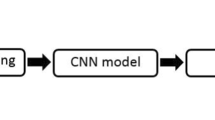Abstract
Automatic brain tumor classification of tissue types plays a significant task in computer-aided medical diagnosis. In recent years, classification of brain tumors types like meningioma (T1), glioma (T2), and pituitary tumor (T3). Convolution Neural Networks (CNN), which trains the image into increasingly sub-dividing as filter blocks for the fine-tune of feature extraction from each sub-region, exhibits excellent results and successfully used for object detection and classification. In this paper, we present an approach to improve tumor detection and classification performance. Initially, the tumor area is clustered with the fuzzy c-means algorithm for discovering the surrounded tumor tissues and also gives important clues for tumor types. Second, the Canny edge detection applied for the tumor region. Third, the spectral residual for saliency map from the tumor region. Finally, we combine all three areas into one representation for CNN training and testing on a large dataset, which gives accuracies of 91.40%. These experimental results show that the proposed method is realistic and useful for the classification of brain tumors types.
Access this chapter
Tax calculation will be finalised at checkout
Purchases are for personal use only
Similar content being viewed by others
References
Aslam, A., Khan, E., Beg, M.S.: Improved edge detection algorithm for brain tumor segmentation. Procedia Comput. Sci. 58, 430–437 (2015)
Shanthakumar, P., Ganesh Kumar, P.: Computer aided brain tumor detection system using watershed segmentation techniques. Int. J. Imaging Syst. Technol. 25(4), 297–301 (2015)
Natteshan, N.V.S., Angel Arul Jothi, J.: Automatic classification of brain MRI images using SVM and neural network classifiers. In: El-Alfy, E.-S.M., Thampi, S.M., Takagi, H., Piramuthu, S., Hanne, T. (eds.) Advances in Intelligent Informatics. AISC, vol. 320, pp. 19–30. Springer, Cham (2015). https://doi.org/10.1007/978-3-319-11218-3_3
Dandıl, E., Çakıroğlu, M., Ekşi, Z.: Computer-aided diagnosis of malign and benign brain tumors on MR images. In: Bogdanova, A.M., Gjorgjevikj, D. (eds.) ICT Innovations 2014. AISC, vol. 311, pp. 157–166. Springer, Cham (2015). https://doi.org/10.1007/978-3-319-09879-1_16
Yazdani, S., Yusof, R., Karimian, A., Riazi, A.H., Bennamoun, M.: A unified framework for brain segmentation in MR images. Comput. Math. Methods Med. 2015, 829893 (2015)
Nabizadeh, N., Kubat, M.: Brain tumors detection and segmentation in MR images: Gabor wavelet vs. statistical features. Comput. Electr. Eng. 45, 286–301 (2015)
Zikic, D., Ioannou, Y., Brown, M. and Criminisi, A.: Segmentation of brain tumor tissues with convolutional neural networks. In: Proceedings MICCAI-BRATS, pp. 36–39 (2014)
Urban, G., Bendszus, M., Hamprecht, F., Kleesiek, J.: Multi-modal brain tumor segmentation using deep convolutional neural networks. MICCAI BraTS (Brain Tumor Segmentation) Challenge. Proceedings, winning contribution, pp. 31–35 (2014)
Zhang, L., Han, Y., Yang, Y., Song, M., Yan, S., Tian, Q.: Discovering discriminative graphlets for aerial image categories recognition. IEEE Trans. Image Process. 22(12), 5071–5084 (2013)
Han, J., Zhang, D., Cheng, G., Liu, N., Xu, D.: Advanced deep-learning techniques for salient and category-specific object detection: a survey. IEEE Signal Process. Mag. 35(1), 84–100 (2018)
Menze, B.H., van Leemput, K., Lashkari, D., Weber, M.-A., Ayache, N., Golland, P.: A generative model for brain tumor segmentation in multi-modal images. In: Jiang, T., Navab, N., Pluim, J.P.W., Viergever, M.A. (eds.) MICCAI 2010, Part II. LNCS, vol. 6362, pp. 151–159. Springer, Heidelberg (2010). https://doi.org/10.1007/978-3-642-15745-5_19
Gering, D.T., Grimson, W.E.L., Kikinis, R.: Recognizing deviations from normalcy for brain tumor segmentation. In: Dohi, T., Kikinis, R. (eds.) MICCAI 2002, Part I. LNCS, vol. 2488, pp. 388–395. Springer, Heidelberg (2002). https://doi.org/10.1007/3-540-45786-0_48
LeCun, Y., Bottou, L., Bengio, Y., Haffner, P.: Gradient-based learning applied to document recognition. Proc. IEEE 86(11), 2278–2324 (1998)
Bengio, Y.: Practical recommendations for gradient-based training of deep architectures. In: Montavon, G., Orr, G.B., Müller, K.-R. (eds.) Neural Networks: Tricks of the Trade. LNCS, vol. 7700, pp. 437–478. Springer, Heidelberg (2012). https://doi.org/10.1007/978-3-642-35289-8_26
Havaei, M., et al.: Brain tumor segmentation with deep neural networks. Med. Image Anal. 35, 18–31 (2017)
Zhang, L., Tong, M.H., Marks, T.K., Shan, H., Cottrell, G.W.: SUN: a Bayesian framework for saliency using natural statistics. J. Vis. 8(7), 32–32 (2008)
Rajkumar, R., Arunnehru, J.: A study on convolutional neural networks with active video tubelets for object detection and classification. In: Wang, J., Reddy, G.R.M., Prasad, V.K., Reddy, V.S. (eds.) Soft Computing and Signal Processing. AISC, vol. 898, pp. 107–115. Springer, Singapore (2019). https://doi.org/10.1007/978-981-13-3393-4_12
Arunnehru, J., Chamundeeswari, G., Bharathi, S.P.: Human action recognition using 3D convolutional neural networks with 3D motion cuboids in surveillance videos. Procedia Comput. Sci. 133, 471–477 (2018)
Author information
Authors and Affiliations
Corresponding author
Editor information
Editors and Affiliations
Rights and permissions
Copyright information
© 2020 Springer Nature Singapore Pte Ltd.
About this paper
Cite this paper
Arunnehru, J., Kumar, A., Verma, J.P. (2020). Early Prediction of Brain Tumor Classification Using Convolution Neural Networks. In: Saha, A., Kar, N., Deb, S. (eds) Advances in Computational Intelligence, Security and Internet of Things. ICCISIoT 2019. Communications in Computer and Information Science, vol 1192. Springer, Singapore. https://doi.org/10.1007/978-981-15-3666-3_2
Download citation
DOI: https://doi.org/10.1007/978-981-15-3666-3_2
Published:
Publisher Name: Springer, Singapore
Print ISBN: 978-981-15-3665-6
Online ISBN: 978-981-15-3666-3
eBook Packages: Computer ScienceComputer Science (R0)




